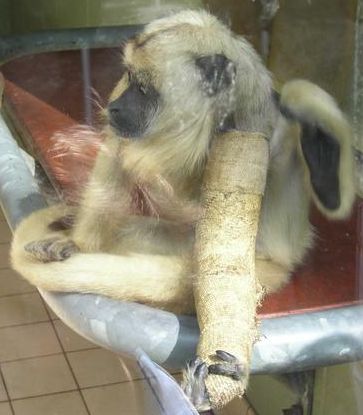Scientists analyzed many skeletons of deceased monkeys and were astonished to discover healed fractures.
Not all of them were exited in the proper direction.
Some of the scientists their standard extinction routine. The rate of bone fractures is from 5 to 30 for free-raging African primates, and this is considered a saddening fact. They will all die. Well, they always do. Eventually.
However, other scientists were keen enough to notice something really weird.
Have you ever seen an ape in a plaster cast?
Well, actually some people have:

But that’s a zoo monkey. I don’t think any of the free-range monkeys sport plaster casts.
For the bones to heal properly, the limb must be immobilized for several weeks. Not that you really wish too, since every motion causes tremendous pain.
If the ape doesn’t move, it will not be able to protect itself and will die from starvation.
Healed fractures mean other primates cared about this poor monkey: protected from predators, brought food and hydrated in some way. Do not really want to think that way was…
That is amazing! According to Darwin, in nature weak and injured species die. In the wild, rats eat up all unhealthy offsprings, weak nestlings get no food from parents, injured rabbits are eaten up by wolves, and so on. This termination of inferior ensures only stronger species survive to pass their genes. That’s how evolution works.
Only humans care for sick people and bring up weak and defective kids, jeopardising future generation genes.
That’s why this feeding an injured monkey for weeks stands out so much. Are the apes more social, as some books suggest. Most species kill or abandon defective cubs. So even if these fractures were received by juvenile species, who still enjoy parental care and thus survived the healing period, it is still amazing.
